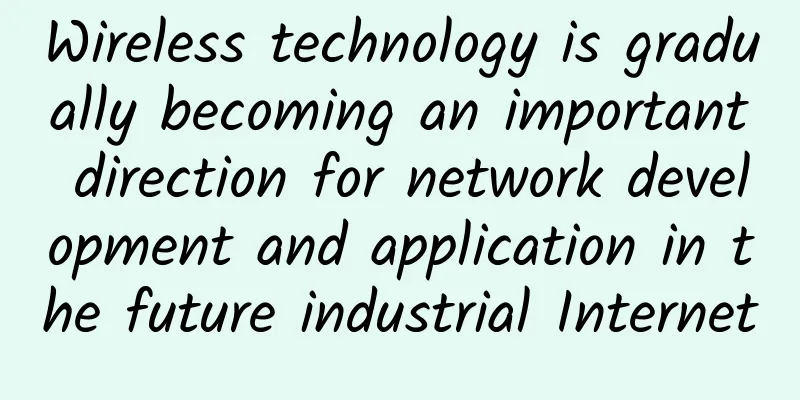Wireless technology is gradually becoming an important direction for network development and application in the future industrial Internet

|
Germany's "Industry 4.0 R&D White Paper" and "Industry 4.0 Implementation Strategy and Reference Architecture" both regard wireless technology as an important part of the research and innovation of Industry 4.0 network communication technology. Among them, Wi-Fi, NFC, zigbee, 2G/3G/4G, LORA and other wireless technologies have become important technologies for connecting the transmission layer. The industrial communication methods at each level are slightly different. The five-level hierarchical architecture has different communication methods at each level. Considering the differences in responsibilities and missions assigned to each level, the industrial communication methods are also different. At the ERP and MES layers, the interconnection is mainly through routers, industrial Ethernet and buses. There are not many changes in the current network communication. At the control layer, the main communication methods are PROFIBUS, MODEBUS, industrial Ethernet and fieldbus, etc.: At the sensing layer, the main communication methods are field bus, wireless network, LTE, ZIGBEE, WIFI, and LORA. Due to the mobility of the equipment, wireless communication networks are widely used. At present, wireless technology is gradually becoming an important direction for network development and application in the future industrial Internet due to its advantages such as easy deployment, low construction cost and wide applicability. Wireless network, as the name implies, is a network data transmission system that uses radio waves instead of cables to achieve location-independent computer equipment. It is an important direction for the development of modern data communication systems. With the mutual penetration and combination of computer network technology, wireless technology and intelligent sensor technology, a new concept of networked intelligent sensors based on wireless technology has emerged. This networked intelligent sensor based on wireless technology enables industrial site data to be directly transmitted, published and shared on the network through wireless links. Wireless communication technology can provide high-bandwidth wireless data links and flexible network topology structures for communication between various intelligent field devices, mobile robots and various automation equipment in factory environments. It effectively makes up for the shortcomings of wired networks in some special environments and further improves the communication performance of industrial control networks. Take the wireless street lights in smart cities as an example. Through ZigBee or LoRa, there is no need to modify the lamps, set up communication lines, modify the power distribution cabinets, and build a huge machine room for analysis and control based on the cloud platform. Whether it is renovation or new construction, wireless is better than wired in terms of construction, cost, later scalability, maintenance, etc. By 2020, there will be more than 50 billion wireless terminals in the world. In the future, more and more application scenarios of industrial communications will be wireless. |
<<: 6 AI Elements You Need for a Wireless Network Strategy
>>: How did Huawei Cloud become a public cloud leader after just over a year in the market?
Recommend
Interpretation of the 8 major links of the Internet of Things industry chain in 2017
1. Composition of the IoT industry chain The Inte...
Why SDN and IBN Require Better Network Visibility
Intent-based networking (IBN) has been a topic of...
With the rise of new infrastructure and other demands, the upgrade of the next generation domain name system is imminent
When it comes to the Internet domain name service...
Smart Encyclopedia | What is a 400G optical module?
As more and more people use the internet, the amo...
5G messaging: The key is how to divide the money
[[439892]] The 5G news that had just been quiet i...
LOCVPS newly launched Russian CN2 line VPS, with a 20% discount on all items and monthly payment starting from 29.6 yuan
LOCVPS has added a new data center product in Eur...
8 Software-Based Network Trends for 2019
As networks become increasingly software-based, l...
Four Best Practices for Network Cable Management
If a cabling project is to be successful, you fir...
COVID-19 pandemic boosts 5G enterprise use cases, study finds
Global technology market advisory firm ABI Resear...
First time: China achieves major breakthrough in quantum relay
Recently, Duan Luming's research group at the...
CERNET and Shengbang Security have reached a strategic cooperation, allowing colleges and universities to experience more efficient and convenient Web security governance SaaS services
[51CTO.com original article] On October 24, CERNE...
SpartanHost Seattle E5 series VPS partial restock, Dallas large hard drive VPS restock
I haven't shared information about SpartanHos...
The number of 5G package customers has exceeded 165 million. China Mobile announced its operating data for December 2020.
Since the Ministry of Industry and Information Te...
How to help enterprises improve the WiFi performance of wireless LAN?
Assuming your company has no money for a wireless...
API becomes the first choice for malicious attacks in 2022. How can enterprises protect API security?
With the vigorous development of cloud computing,...









